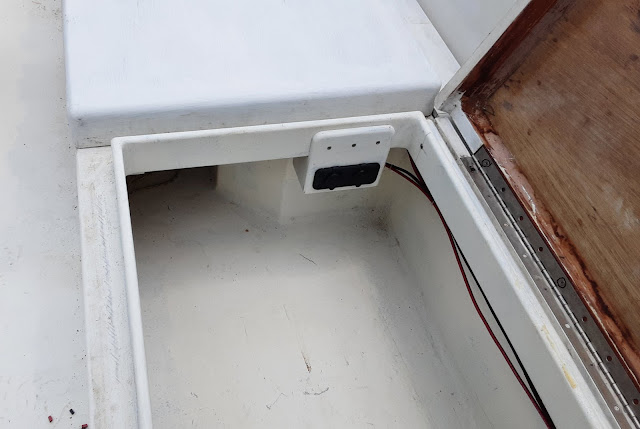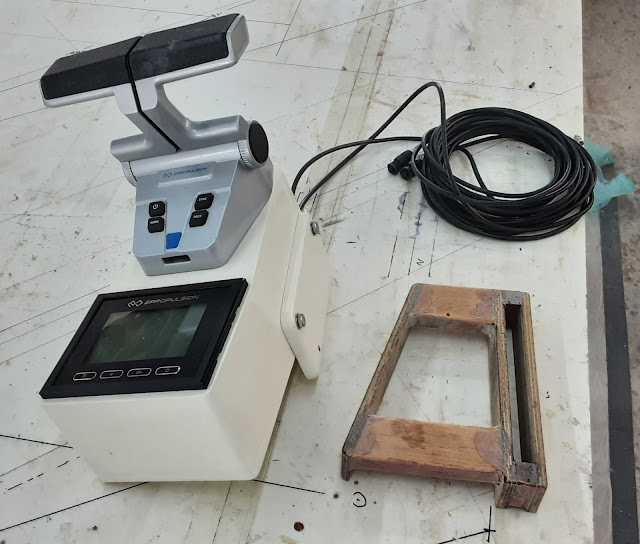September 2025 marks the eighth year of this boat construction project. I am now willing to offer an answer to the most annoying boat question I previously railed about. That question is; when will the boat be launched? I can now answer; in the coming new year, 2026, the boat should launch. I realized this as I began construction of the last major boat component, the mast.
I have chosen to deviate from the plans to build a traditional bird's mouth octagon hollow mast as shown above. The plans detail a mast round mast starting from a hollow square cross section. The bird's mouth mast employs a special router bit and is a more complex construction method than that detailed in the plans. The mast is composed of eight staves 3/4" thick and 26 feet long. The inscribed circle defines the material to be removed producing a round mast five inches in diameter.
It is desirable to have a mast that is light as possible. The locally available wood is on the heavy side with the exception of spanish cedar which has properties similar to sitka spruce often used in marine spars. I procured enough spanish cedar to build the mast and milled it to the correct thickness and width. In this process it was revealed that some of this material was unusable with voids of rot. I continued on, scarfing the usable material into 26 foot lengths. A search for additional spanish cedar proved fruitless as no one is farming these trees. I now have a pile of wood that I have no use for and an alternative is needed.
Mahogany proved to be the answer. I estimate that a mahogany mast will have a weight penalty of 18 pounds over the spanish cedar mast, but will be stronger. I will not end up with a racing boat, but perhaps an overweight cruiser. The milling, cutting to length and width as well as scarfing into 26 foot lengths was repeated. This also required another lumber yard trip as one length was not usable.
The shop has become increasingly chaotic as this project continues. There are various finished parts, components and machinery scattered around. These items have to be repeatedly relocated to accommodate the various stages of mast construction. Hopefully, these items are readily located when needed.
Cut the Bird's Mouth
Two passes through the router table cut the bird's mouth into one edge of the 26 foot staves. In the foreground is a feather board that presses the stave against the fence. Two blocks are screwed to the fence on either side of the router bit to keep the stave against the router table face. This arrangement assured the cut was uniform along the length.
Assembly Fixtures
A short mast length was constructed from spanish cedar to test if it could be assembled to the expected dimensions. This also helped to define the U shaped assembly fixture on the right.

Above the assembly fixtures are aligned and installed on the bench. A fishing line tensioned between the mast foot and masthead defines the fixture's horizontal position using a round wooden gage between the line and the fixture. A six foot level spans four fixtures to set the fixture's elevation. The fixture's vertical rotation, relative to the mounting block, is adjusted using a small level is placed across the upright fixture legs. A change in one setting influences the other settings so much back and forth adjustment is required.
Mast Assembly
The mast was assembled in two sections, one with three staves and one with five staves as shown, partially assembled, above. This approach allowed the installation of the mast foot, masthead and other items in the mast internal volume.
The upper end of square mast foot has been cut into an octagon shape to fit inside the mast. Two electrical conduits are installed along the mast length. One conduit will supply power to the masthead navigation/anchor light. The remaining conduit is for future purposes. The three stave section lays next to the five stave section in the assembly fixtures.
Radar Reflectors
It is desirable that a wooden boat is visible to larger vessels on radar. To that end, five radar reflectors were constructed for installation high in the mast. The reflector is basically an empty box with equal dimensions on all faces that is cut in half corner to corner. The box interior is covered with aluminum to provide a radar reflective surface. In this case the cut in half box sections are conjoined to provide larger reflective surfaces. A radar pulse entering the reflector may bounce around the reflector a few times before it is redirected to the source. Effective reflections are possible over a 90° angle to the open face. Given this and the internal mast geometry constraints, five reflectors were constructed to hopefully provide radar returns 360° around the boat.

The orientations of four of the five radar reflectors can be seen as installed just below the masthead. The fifth reflector is installed similar to the one marked 4, but the open face is turned 180°. It remains to be seen if this is effective for all around radar returns.
The masthead is a lamination of solid mahogany octagon shaped to fit inside the mast. Two grooves were cut into this lamination to extend the conduits through the mast top. The lamination will later receive large screws holding shrouds and forestay fixings to hold the mast upright.
A friend and neighbor, a vigorous 80+ year old man, helped with epoxying the mast sections together. I could not have completed this without his help as the high temperatures would set the epoxy before it could be applied and assembled. He also helped with cutting the bird's mouth in the 26 foot staves. We are sure to enjoy some beers and boat rides in the future. In the nearer future I'll be enjoying turning this 26 foot octagon into a circle, but that is for the next episode.
Trampolines
The fore and aft web mesh trampolines have arrived and test fitted on the boat. They should look really triffic when properly laced and tensioned in place. The boat will be disassembled before launch to complete the painting and lacing holes. I specified the optional protective UV coating to extend the trampoline life. This coating is surprisingly sticky in the newly coated state.
After living in Belize for nine years I've almost achieved permanent residency. This is something I could have done after my first year here, but kept putting off. I've paid all the fees, submitted and resubmitted paperwork while I await the residency card to be mailed to Corozal. I no longer have to go through the immigration shuffle while paying $200 BZE a month to live here. Also there is no fear of being disappeared by masked men while going through the legal process as in one North American country.

























.jpg)









